Running an eCommerce store has multiple advantages as opposed to retail businesses, one of which is the condensed functionality of all the cogs in the system. Let’s say you’re using WordPress along with WooCommerce. Everything is integrated and intertwined with everything else to the point where you hardly have to leave the dashboard. This uniformity in approach accompanied by a user-friendly interface enables users to quickly get the hang of things.
Now at the heart of every online store lie orders. You’ll go through a host of analytical data that shows the number of successful/fulfilled orders, abandoned orders/carts, filtered and sorted stats about orders based on location, age, spoken language, etc. To put it short, traffic generates orders, which generate revenue – in the long run, each of the three is dependent on the former, and without every link in the chain performing, you’ll end up closing shop sooner or later.
Here we’ll be focusing on the orders themselves, more precisely how to export WooCommerce orders into files you can use for further analysis, in reports, for future reference, etc. For this task, we’ll be using the WooCommerce Order Export plugin.
Export WooCommerce orders with a click
Exporting orders in WooCommerce has never been easier than with this simple plugin that does precisely as advertised – integrates a wide variety of ways to get tables with order data exported from WordPress to be used elsewhere.
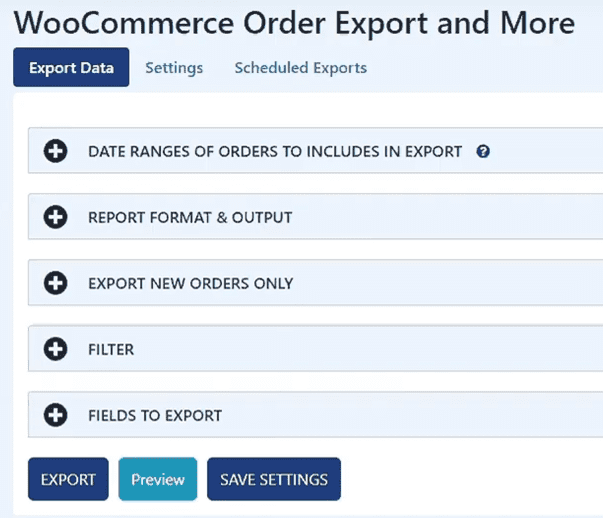
The WordPress tool is divided into three sections – export data, settings, and scheduled exports. The principle in which the export tables function is very much like other reports you’ve, more than likely, encountered at some point. Going through all the features and functions is quickly and easily accomplished, even for newcomers, and that accessibility is certainly one of the reasons we’ve found this WooCommerce export orders plugin to be such a good enhancement for anybody using WooCommerce as their preferred eCommerce platform.
Date ranges
The first thing you’ll need to configure is the date range from which the report will gather data. This entirely depends on what you want the report to reflect. You could use it as a daily or weekly report to see the current situation, look at the entire year for an overall sense of scope, or any other timeframe you need for possibly comparing it to the same period a year or two ago. To help you out, you’ll be presented with seven predefined ranges where just a click is enough to get you started. In case you don’t find the desired range, there’s always the option of selecting your own custom range.
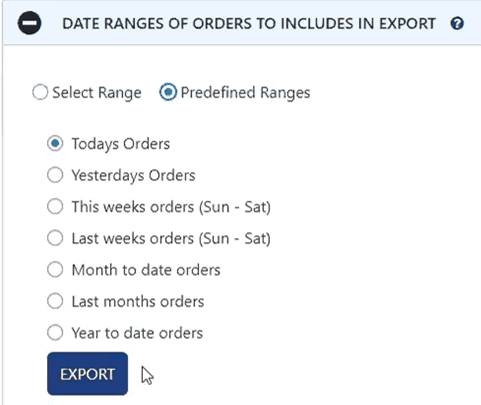
Report format and output
Selecting the range from which your data will be gathered is just the first step to getting your WooCommerce export orders out. Once the dates are set, you’ll need to address formatting and output. This section, although not similar in terms of user interface but instead, functions, closely resembles the sort and filter sections of an Excel spreadsheet and will therefore surely be instantly recognizable.

You’ll be able to choose by which value to sort the data and in which order (ascending or descending); once more, this relies on the way you’ll be using the report. Furthermore, you’ll need to set the date and time format – this is extremely important based on where you operate from, because of the distinct differences in the way dates and times are used around the world (the US and Europe represent prime examples, especially where dates are concerned). Other setup items include the filename, character encoding, field delimiter, and line break – all rather straightforward stuff, finished by how you want your items to be formatted within the table – each line item in a separate row being the default option, or alternatively, each line item in a separate column.
Export new orders
This feature shows the scope of how much work the plugin does in the background without us noticing. Namely, all WooCommerce export orders are stored, i.e., the plugin remembers them as already being exported. You can therefore use this feature to export just the new orders (the ones that haven’t been exported yet). An option like this can be immensely helpful if you’re looking for reports for a shorter time period, such as daily reports.
Enabling the option means you won’t have to manually sift through data you’ve already gone through, and instead, you’ll get a clean, up to date, table each time. Keep in mind that if you want the plugin to automatically filter out new orders in the export, just tick the box, but if you want to manually set the first order after which all others are extracted, use the field.

Filter
Just as the name suggests, you’ll get to filter out the fields you want to be featured in your table. The filter options are divided into three main ones – order, product, and coupon. To implement a filter, there are three attributes you’ll need to set up. First among them is the type of filter you’ll be using (for example, currency), second is the condition (usually is/isn’t equal to), and finally, the value (in case of currency USD, EUR, etc.). You’ll be able to stack as many filters as you want to get an export table perfectly suited for your needs.
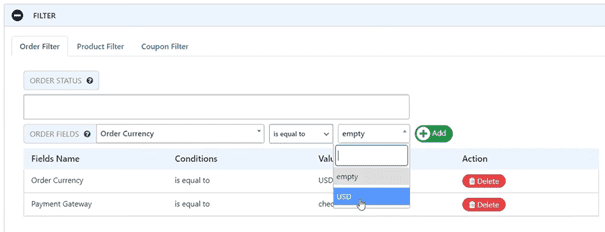
The product filter focuses on products instead of orders, so filters are about individual products or product categories. Coupons are very similar to filters. If you’ve done any promotions and want to single out only orders that include coupons, this will be the place to do it.
Fields to export
While filters single out the orders you want to have featured in your report, here you get to choose which fields are present in the same report. This is also the section you’ll probably be doing most of your work in because of the sheer depth that can be found.
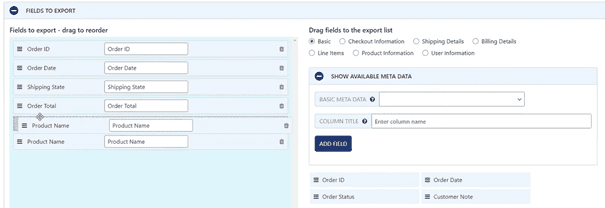
The window in which you operate is divided down the middle into two distinct sections. On the left side, there are the fields that will be on the export, while on the right, you’ll have all the fields that are at your disposal and that you can add to the report. The process of adding fields is a simple drag and drop motion. The same goes for positioning “active” fields in any order you wish while removing them requires just an appropriate click (also on the “active” side). By using this effective method, you can create various custom reports that can cover a whole plethora of situations in mere minutes.
The categories you can choose the fields from include: basic, checkout information, billing details, line items, product information, and user information. Each category has a number of fields you can add, and there’s even an option to add a large selection of metadata if you have another plugin or add-on that gathers them for your site. Field selection varies from basic data like “order total” to things like “coupon code” and everything in between.
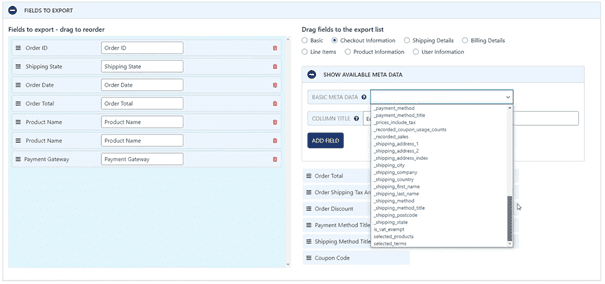
Preview
Before you export WooCommerce reports, it’s always a good idea to see how the final table will look. That’s why the preview function comes in handy – it shows you the complete set of fields that will be present in the final table but cuts down the number of items to the first 25. If nothing else, this can be seen as a time saver where you can make numerous changes and preview them directly in the dashboard without having to export the report every time.
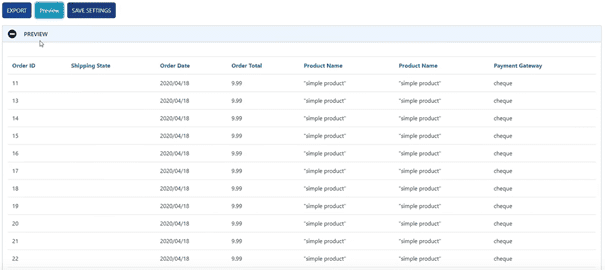
Settings
The settings section is rather straightforward, consisting primarily of the log that you’d potentially use from time to time. Just like any “history recording” function in any app you use, a log doesn’t have much use until something goes wrong and/or needs to be checked. Outside of the log, you can see the basic settings of the plugin, export them if you’re starting to use the plugin on a different site, or import them if this is the new site you’re bringing up.
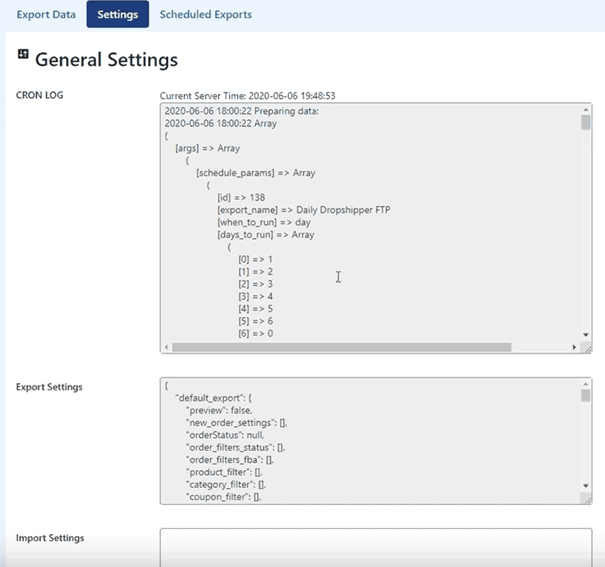
Scheduled reports
Up until this point, everything we’ve touched upon has been manual exports and reports. However, there’s a high demand to export WooCommerce reports on a schedule. Just imagine running a site that has hundreds of orders every day that you have to create daily reports for, manually. That amount of work would certainly be significant. In those cases, setting up an automated schedule with this WooCommerce export orders plugin will be a lifesaver.

You’ll be able to create schedules for numerous exports, all with varying frequencies, depending on how often you’ll need a specific report. Setting up each report is almost the same as you would do it for the manual export, with minimal additions.
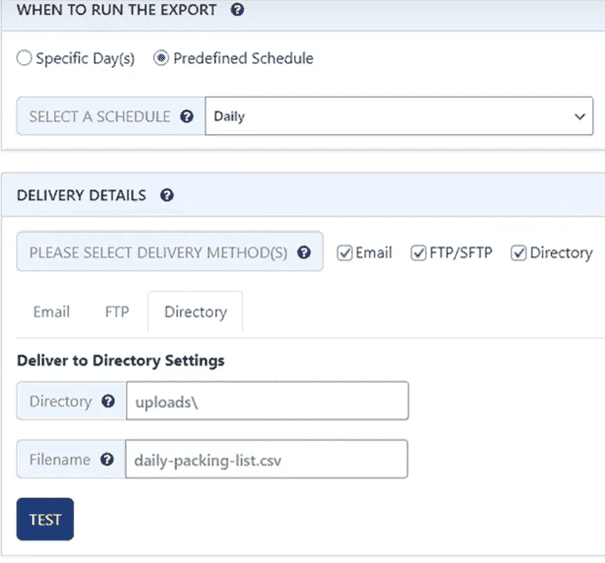
Before getting to the regular menu we’ve already covered, you’ll have to set up when to run the export and how it’s delivered. For delivery times, you can set specific days or use a predefined schedule (daily, weekly, etc.) that fits what you’re going for.
Depending on how you operate and manage your site, there are three ways these exports can be delivered – by mail, through FTP, or stored directly into a directory within WordPress. Each of the choices will require you to fill in some basic information into a couple of fields, and you’ll be good to go, simple as that.
Summary
Running all kinds of analytical tasks has become a key part of every successful business, eCommerce, or another kind. A crucial part of that – analysis reports – you can only get through plugins that pull specific data from your site’s database.
Now, since orders are such a big part of the whole thing, it stands to reason that having a plugin that can export that crucial data both manually and automatically is something that is a must.
Therefore, taking everything into consideration, everyone running their store through WooCommerce should take a long, hard look at a WooCommerce export orders plugin and implement it into their site.